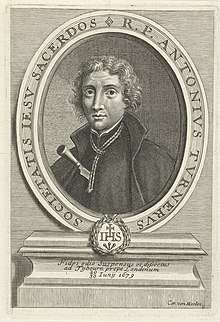Anthony Turner (martyr)
Blessed Anthony Turner (1628–1679) was an English Jesuit. He was a victim of the fabricated Popish Plot, who was falsely accused, convicted and executed for conspiracy to murder Charles II. He was beatified in 1929.

Life
He was born in Leicestershire, the son of a clergyman, Toby Turner, who was Rector of Little Dalby. He went to Uppingham School in Rutland, then studied at Peterhouse, Cambridge,[1] where according to tradition he converted to Roman Catholicism. He went to the English College, Rome and then to the Jesuit College, St Omer. He was ordained in 1659. In 1661 he was sent to staff the Jesuits' Worcestershire mission and he remained there for the rest of his career; in due course he was appointed Jesuit Superior for the District.
Trial and execution
On the outbreak of the Popish Plot the Government showed exceptional interest in apprehending Turner. Why he was considered to be of such importance is unclear, but he must have been thought worth catching, as he was searched for in three counties.[2] Turner, like many of the accused priests, fled to London, no doubt with the intention of escaping from England by taking refuge in the embassy of one of the Catholic powers; but while arrangements were being made through the embassies to smuggle him out of the country he voluntarily gave himself up to the authorities in February 1679. His motives for doing this are unclear: Jesuits, though they were schooled to endure martyrdom where necessary, were not expected to actively seek it, nor does his spirited defence at his trial suggest that he had any such wish. It is most likely, as J. P. Kenyon suggests, that his physical and mental suffering had caused him to suffer a short-lived nervous breakdown.[3]
He was tried on 13 June 1679 together with Thomas Whitbread, John Fenwick, John Gavan and William Barrow.[4] No fewer than seven judges sat on the court that tried them, headed by the Lord Chief Justice, Sir William Scroggs, who was a convinced believer in the Plot and cherished a deep hatred of Catholic priests. Turner, having recovered his mental balance, defended himself with vigour, although the four older priests allowed the young and able John Gavan to act as the principal spokesman for all five. Attempts to discredit the testimony of Titus Oates, the inventor of the Plot, by proving that he had been in St Omer for six months when he claimed to have been in London failed, as the Court ruled that the witnesses, being Catholics, could receive a dispensation to lie and were therefore not credible. Far more effective were the direct attacks on Oates himself; in particular, the accused were able to show that though Oates knew Whitbread and Fenwick personally, Gavan was a stranger to him. Oates's evidence against Gavan was so feeble that even Scroggs remarked "I perceive your memory is not good".[5] Despite the obvious weaknesses in the prosecution case, Scroggs summed up firmly for a conviction, and the jury delivered a guilty verdict within fifteen minutes.
All five were hanged at Tyburn on 20 June 1679. The well-known story that they were offered a royal pardon on the scaffold if they would confess seems to have no foundation. Charles II was asked to show clemency, but refused, for fear of inflaming public opinion; the most he would do is order that the five be allowed to hang until they were dead, that they be spared drawing and quartering and given proper burial.[6] The crowd showed that its sympathy was with the victims, and stood in respectful silence while each of the condemned men delivered a last speech maintaining his innocence. They were buried in St Giles-in-the-Fields.
References
- "Turner, Anthony (TNR644A)". A Cambridge Alumni Database. University of Cambridge.
- Kenyon, J.P. The Popish Plot 2nd Edition Phoenix Press London 2000 p.162
- Kenyon p. 251
- Kenyon, p.180
- Kenyon p.181
- Kenyon pp.190–1